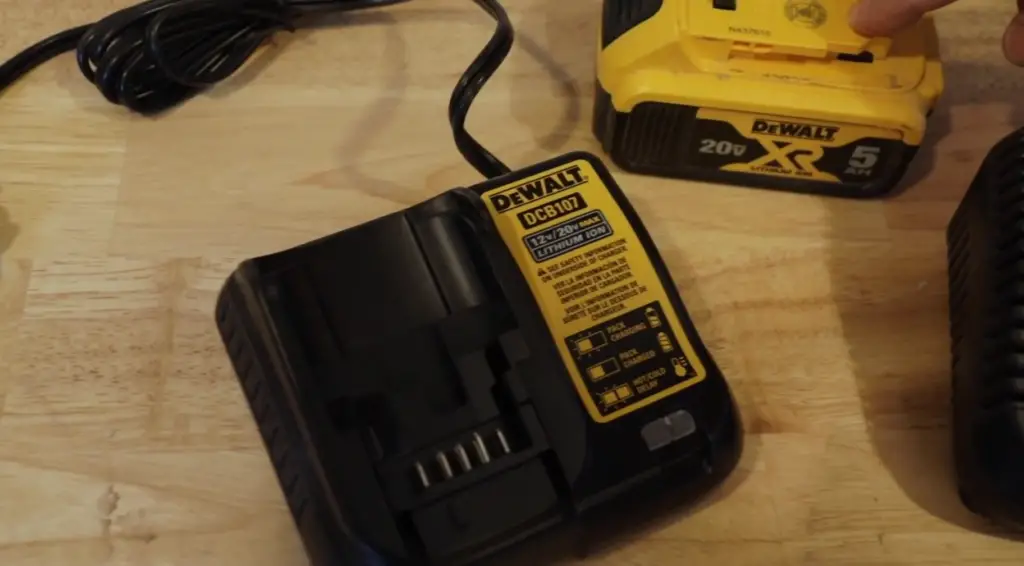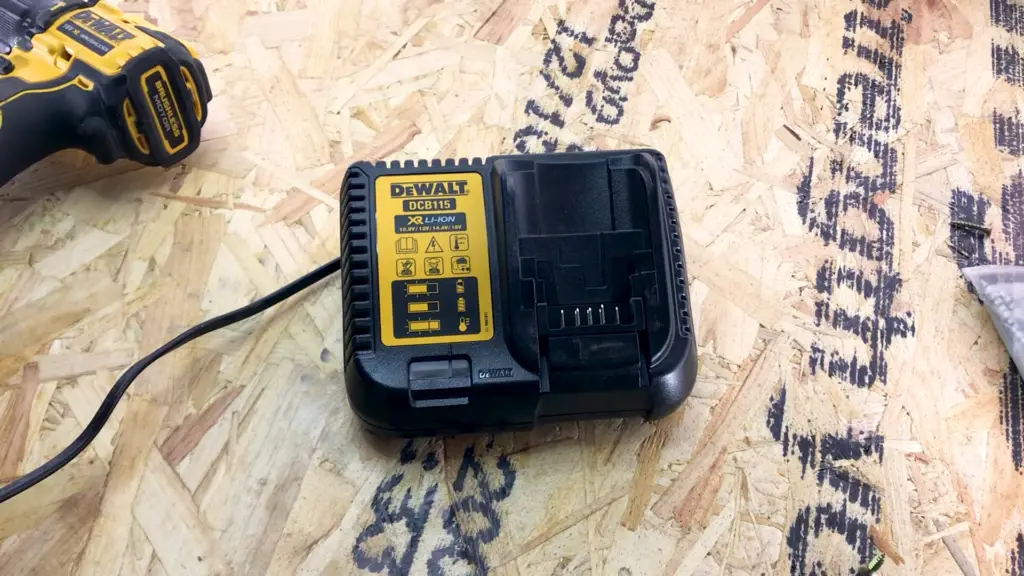If you are in the power tool market searching for the best multi-volt charger for your DeWalt 12V or 18V tools. I can imagine how perplexing it would be to choose from a wide range of DCB chargers. The DCB family consists of dozens of members that offer almost similar advantages.
Especially, the DeWalt 107 and 115 have the same features apparently, but with a bit of difference.
Although both tools are compatible with 20V batteries, you should know the difference to decide which is best for your requirements. In this ultimate guide, we empower you to differentiate the DeWalt DCB107 vs DCB115 with distinctions.
Let’s dive deeper to explore the detailed features, pros, and cons of both gears.
DCB107 vs DCB115 Major Difference
The main difference between DCB107 and DCB115 is the amps output rating. DCB 107 comes with 1.5 amps, while the DCB 115 boasts 4.0 amps. This amp rating enhances the charging capability of the battery. That’s why DCB 115 is 2X faster with a lower price than DCB 107.
Dewalt DCB107 vs 115 Comparison Chart
Although the DeWalt DCB 107 and 115 have a great resemblance and similar specs. But also different to a great extent when analyzing extensively. After using these chargers for a few weeks, we discuss all the ins and outs unbiasedly. Maybe this review saves you from the hassle of time-consuming research.
For a quick review, look a glance at this detailed comparison table that differentiates both gears side by side.
| Features | DeWalt DCB107 | DeWalt DCB115 |
| Battery Chemistry | Lithium-ion | Lithium-ion |
| Output Rating | 1.5 amps | 4.0 amps |
| Input Voltage | 120V | 120V ( for 220V, use a compatible adapter) |
| LED Diagnoser | Yes | Yes |
| Charging Time | 1 Hour | 30 Minutes |
| Weight | 0.69 Ounces | 0.016 ounces |
| Dimensions | 5″D x 5″ W x 3.5″H | 3.8″D x 7.6″W x 1.3″H |
| Compatibility | 20V max Lithium-ion batteries | 20V max, XR 20V, FlexVolt 20V/60V batteries |
| Wall Mountable | Yes | Yes |
| Energy Efficient | Yes | Yes |
| Material | Plastic | Plastic |
| Price | $26 | $21 |
DeWalt DCB107

Technical Specifications
- Product Dimensions: 5″D x 5″W x 3.5″H
- Input Voltage: 120 Volts
- Charging Time: 1 Hour
- Compatibility: 12V to 20V DeWalt Lithium-ion
- Power Status Indicator: Yes
- Output Rating: 1.5 amps
- Weight: 0.69 ounces
DeWalt DCB 107 is a high-quality multi-volt charger that is compatible with DeWalt 12V-20V Lithium-ion batteries. It works with the 120V voltage input power. It means you can use it if your electric power outlet delivers 20V. Don’t use it if the voltages are too low or too high. In some localities, the power is as high as 220V. Don’t directly use it to 220V otherwise, it can be damaged.
It comes equipped with 1.5 amps which is extremely helpful in cutting down the charging time. Regarding accurate and fast charging, the DCB 107 is much better than the older version of the DCB101. After 101, DeWalt also introduces DCB102 and DCB104, but both chargers are specifically made for charging dual batteries simultaneously.
These batteries have high amps and jaw-dropping price tags for budget buyers. Therefore, DeWalt has launched the DCB 107. It’s not only a single charger in a minimal price range than its predecessors. In weight and dimensions, it’s larger and heavier than its successor DCB 115. Due to the latest technology, it boasts diagnostic LED lights that inform you clearly about the current power status of your battery. You can easily assess whether your battery is “charging,” “charged,” or “hot/cold delay.”
DCB 107 is an environment-friendly gear that produces less heat compared to other heavy and fast chargers. Less heat production means less electricity consumption. Moreover, less electricity consumption means saving a lot on behalf of electricity bills.
High-quality plastic construction makes it a durable and long-lasting charger. Its robust build quality enhances its battery charging performance smoothly and accurately.
Pros
- Bet quality construction with premium plastic.
- Fast charging in 1 hour than its predecessors.
- It provides longevity and enhances productivity.
- Diagnostic LED lights show battery status.
- Compatible with DeWalt 12V-20V Lithium-ion batteries.
- Works well on 120V input power.
Cons
- Charging slowly than DCB 115 but produces less heat.
DeWalt DCB115

Technical Specifications
- Product Dimensions: 3.8″D x 7.6″W x 1.3″H
- Input Voltage: 20 Volts
- Charging Time: 30 minutes
- Compatibility: 12V to 20V DeWalt Lithium-ion, FlexVolt 20V/60V batteries
- Power Status Indicator: Yes
- Output Rating: 4.0 amps
- Weight: 0.016 ounces
In terms of reliability, durability, and productivity, DCB 115 is 2X superior to its elder brother DCB 107. Its strong build quality with premium quality light and durable plastic. It comes with a wall mounting capability that makes your work area clutter free and mess-free.
Moreover, the wall mountable system saves the charger and battery from being damaged by unintentional shakes and jerks. On a quiet corner of your workshop, it safely charges DeWalt batteries without any charging issues.
It consists of 4 amps that are up to 2X more than DCB 107. With faster charging ability, it charges the battery within half the time as DCB 107 with 1.5 amps. So, it cuts down the charging time of the same battery from 1 hour to 30 minutes.
Additionally, it minimizes the downtime of the battery. Unlike ordinary chargers that indicate the full battery charging but during usage battery deceives in the midst. Therefore the Dewalt DCB 115 is a better choice than 107.
It’s not the end of the story; stay here and look at the more stunning feature that makes it the apple of DIYers, hobbyists, and professionals’ eyes. It stands firmly with you like a loyal lover while working on heavy-duty applications. But it offers you optimal advantages if you have power tools with two batteries. When you’re utilizing one battery, meanwhile, it’s on the way to charging the other.
Furthermore, the LED light indicators illuminate to make you aware of the power status of the battery. When the battery is charging smoothly, it calms you, indicating “charging.”
When the battery is completely charged, it informs you by showing the status with the specific word “Charged,” as well as if the battery faces any issue with charging, it warns you that “Hot/Cold Delay.”
As far as its compatibility is concerned, you may be amazed to see that it can charge the different 20V XR batteries, FlexVolt 20V/60V, and 12V to 20V max Lithium-ion batteries as well. You can use it to charge up to the 250 DeWalt power tools batteries.
It’s a cost-effective option than DCB 107. By considering DCB 115, you can enjoy much more benefits in the form of features and technical specs than 107. It also costs you fewer dollars than DCB 107. It will prove to be a bigger band for your buck.
Some users complain about battery fitting. It’s not a big deal; you just have to learn how properly insert the battery. Try to fix it until you hear an audible click sound. When the terminal of the battery and charger fix together, there will be no charging issue or losing battery issue.
DCB 115 comes in small and compact sizes with rather different dimensions than DCB 107. That’s why it’s portable and easy to carry in a backpack or your hand-carry toolbox. You can not only use it with extraordinary ease at your home & workshop but also at on-site workplaces.
Pros
- Fast charging and minimizing downtime.
- Wall mountable technology.
- Innovative technology provides the latest features.
- LED light indicators of power status.
- Versatile and reliable.
- Robust build quality.
- 2X faster than DCB 107.
- Compatible with a wide range of lithium-ion batteries.
- Budget-friendly gear.
Cons
- Some users complain about battery fitting, but it’s adjustable.
DeWalt DCB107 vs 115 Differences
Although the DeWalt DCB 107 and 115 have a great resemblance and similar specs. But also different to a great extent when analyzing extensively. After using these chargers for a few weeks, we discuss all the ins and outs unbiasedly. Maybe this review saves you from the hassle of time-consuming research.
For a quick review, look a glance at this detailed comparison table that differentiates both gears side by side.
Considerable Factors Before Buying
Buying a charger that would be the best value for your money and gives you long-term benefits in an undaunting task. It situation becomes more complex when the tool market is flooded with various choices. So consider these factors to choose wisely.
1- Appropriate Input Voltage
The input voltage is the essential factor, you should consider before buying the charger. If the charger is not according to your wall power outlet, it can damage the charger or sometimes cause the failure of the charger’s internal system. Most of the charger supports 120V. But if your outlet produces a higher or lower voltage, you should buy an adapter and transformer to use it accordingly.
2- Charging Time
Charging time is a crucial factor that saves you from the hassle of frequently removing and inserting the battery into the charger of the tool. The charging time affects your tool & battery as well as your working speed. So choose a charger that not only provides you with fast-speed charging but also minimizes the downtime of battery consumption.
3- High AMPs Input Rating
Choose a charger with high amps input rating. The higher the amp’s input, the faster the charging process. With the latest technology, the high amps charger is more power efficient and produces less heat to save electricity costs.
4- LED Light Indicator
The LED light indicator is the innovative technology that old chargers are deprived of. Before buying, make sure your charger must have an LED light indicator. Until or unless your charger hasn’t a light indicator, how can you assess the power status of your battery? This indicator offers you the clear charging status of your battery.
5- Price
Price is also a considerable factor. It depends on your personal preference to choose the costly or cheap charger. Firstly, determine your budget, then analyze the different chargers by their specs, features, pros, and cons. Then make a choice according to your requirements and budget.
Conclusion
After the detailed, fair, and honest review of DeWalt DCB107 vs DCB115, we recommended you the best choice in short words. If you want a high-speed, compact, lightweight, and cost-effective DCB charger, go with the DCB 115. On the other hand, if the speed or budget is not an issue, the DCB107 is an energy-efficient fellow and environment-friendly choice. Consider your need in light of our valuable review and make a decision preferably.

